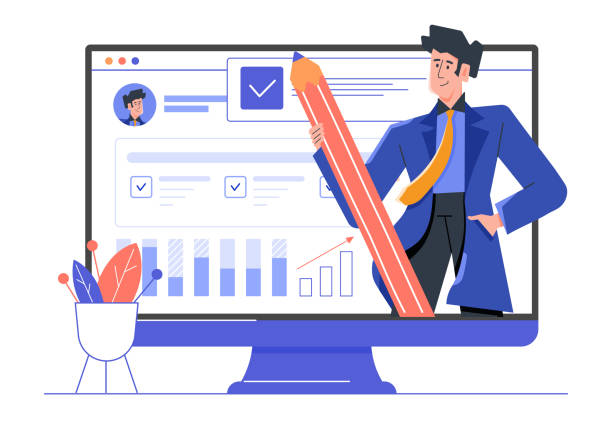The Importance of Speed in Website Design and its Impact on User Experience

In today’s fast-paced world, website loading speed is not just an advantage, but a #vital necessity for the survival of any business in the online space.
Fast website design is the first step to capture visitors’ attention and retain them on your website.
Research shows that most internet users do not tolerate even a second of delay in page loading and quickly leave the site.
This directly affects the #Bounce_Rate; the slower the site, the higher the probability of users quickly leaving.
Website loading speed not only positively impacts user experience (UX) but also plays a key role in improving your site’s ranking in search engines.
Google and other search engines consider speed as an important factor in page ranking.
Therefore, an effective Search Engine Optimization (SEO) will be incomplete without considering site speed.
Fast website design not only satisfies users but also helps reduce server and bandwidth costs, as less data is required for loading.
This is a long-term investment that will yield significant returns.
A website with high web performance not only attracts users but also encourages them to interact more and ultimately convert into customers.
This section explains the primary importance of speed.
Does your current corporate website not reflect your brand’s credibility and strength as it should? Rasaweb solves this challenge for you with professional corporate website design.
✅ Increase visitor credibility and trust
✅ Targeted attraction of more customers
⚡ Click to receive free consultation!
Technical Factors Affecting Site Loading Speed

To achieve fast website design, understanding the technical factors that affect its performance is essential.
The first factor is hosting.
Choosing a high-speed and reliable hosting service with powerful servers and sufficient bandwidth is the foundation of a fast site.
Using a Content Delivery Network (CDN) can also significantly increase loading speed, as CDN stores static website content on multiple servers in different parts of the world, allowing the user to receive content from the closest server.
Image optimization is also a critical factor.
High-volume images can severely slow down the site.
Using appropriate image formats (like WebP), compressing images without noticeable quality loss, and lazy loading images are effective solutions in this regard.
Also, optimized and clean coding, removal of extra code, and use of efficient CSS and JavaScript structures are other important technical factors in increasing web speed.
Minimization of CSS, JavaScript, and HTML files by removing whitespace and unnecessary characters helps reduce file sizes and, consequently, loading speed.
Proper database selection and configuration also play a role in overall site performance.
This section is a specialized guide that delves into technical details.
Website Performance Optimization Tools and Techniques

To achieve a fast website design, there are numerous tools and techniques that developers and web administrators can utilize.
One of the most important techniques is caching.
Caching allows the website to store a version of page content and, in subsequent visits, quickly serve it from the cache to the user instead of reprocessing.
This is particularly effective for dynamic sites where content is constantly fetched from the database.
Tools like Google PageSpeed Insights and GTmetrix are very useful for analyzing site performance and providing optimization suggestions.
Gzip or Brotli compression is another technique that significantly reduces loading time by decreasing the size of files sent from the server to the browser.
| Tool | Primary Use | Description |
|---|---|---|
| Google PageSpeed Insights | Performance analysis and optimization suggestions | Provides scoring for mobile and desktop and a list of necessary actions. |
| GTmetrix | Comprehensive performance and structural report | Displays Waterfall Chart and detailed suggestions. |
| Smush (WordPress Plugin) | Image optimization and compression | Reduces image size without significant quality loss. |
| WP Super Cache / LiteSpeed Cache | Caching Plugins (WordPress) | Stores static pages for faster loading. |
Database optimization, cleanup of old and unnecessary data, and proper indexing can also help improve web performance.
Also, using system fonts or optimizing web font loading with `font-display: swap` can prevent Flash of Unstyled Text (FOUT) and improve user experience.
This section is educational and analytical, focusing on practical solutions for fast website design.
The Impact of Site Speed on Conversion Rate and SEO

Fast website design directly impacts the Conversion Rate and the site’s position in search engines.
A slow website not only frustrates users but can also mean losing sales, registrations, or any other desired action.
Numerous studies have shown that with every second of delay in page loading, the conversion rate significantly decreases.
For example, Amazon has reported that a 100-millisecond delay can lead to a 1% decrease in sales.
This is analytical content that shows you why you should care about site speed optimization.
From an SEO perspective, speed is an official ranking factor by Google.
High-speed websites have a greater chance of appearing in top search results, as search engines aim to provide the best experience to their users, and speed is a crucial part of this experience.
Furthermore, loading speed also affects search engine ‘crawling’; the faster the site, the more pages crawlers can index in less time, leading to better coverage of your site in search results.
Therefore, a high-speed site not only means more satisfied users but also more visibility and higher organic traffic.
This direct relationship between speed, user experience, and SEO doubles the importance of increasing web speed as a key strategy in digital marketing.
Did you know that poor online store design can drive away up to 70% of your potential customers? Rasaweb revolutionizes your sales with professional and user-friendly e-commerce website designs.
✅ Significant increase in sales and revenue
✅ Full optimization for search engines and mobile
⚡ [Get Free Consultation from Rasaweb]
Mobile-First Approach and Website Speed

Given the increasing use of mobile devices for internet access, the ‘Mobile-First’ approach in fast website design has gained increasing importance.
Google and other search engines now primarily consider the mobile versions of websites for indexing and ranking.
This means that if your website is slow on mobile, even if it performs well on desktop, you might lose your rankings.
For a responsive and fast mobile site, specific optimizations are necessary.
These include Responsive Design, which allows the site to adapt to different screen dimensions, using images with appropriate resolution for mobile, and minifying CSS and JavaScript codes specifically loaded for mobile.
Furthermore, emerging technologies like Accelerated Mobile Pages (AMP) and Progressive Web Apps (PWA) play a significant role in website loading speed on mobile devices.
AMP transforms web pages into lighter versions that load quickly, while PWAs provide a user experience similar to native applications with speed and offline capabilities.
Focusing on Core Web Vitals, which include LCP (Largest Contentful Paint), FID (First Input Delay), and CLS (Cumulative Layout Shift), is crucial for optimizing mobile performance.
This section is specialized and provides guidance, describing the mobile-first approach as an important aspect of fast website design.
Common Mistakes That Reduce Site Speed

On the path to achieving a fast website design, there are some common mistakes that can render optimization efforts ineffective.
Understanding and avoiding these mistakes is essential for increasing web speed.
One of the biggest mistakes is using high-volume images without proper compression.
Images typically constitute the largest part of a web page’s size, and not optimizing them harms site speed.
Another mistake is not using caching or misconfiguring it.
Without caching, every time a user visits a page, the server has to process and send all content from scratch, which is time-consuming.
Large and unoptimized CSS and JavaScript files are also factors contributing to site slowness.
Loading too many of these files or not minifying and combining them can lead to an increase in HTTP requests and page rendering delays.
Choosing an unsuitable and cheap hosting is also a common mistake.
Poor hosting, even with the best coding, cannot provide the desired speed.
Overuse of plugins and extensions, especially in content management systems like WordPress, can also lead to site slowness, as each plugin loads additional code.
This section is educational and descriptive, helping site administrators avoid falling into these traps and move towards a high-speed site.
Future Trends in Website Performance and Speed

The web world is constantly evolving, and with it, new trends in performance and fast website design are emerging.
The future of website speed is tied to technologies that offer smoother and faster user experiences.
One of these trends is the wider adoption of HTTP/3, built on the QUIC protocol, which promises faster and more reliable loading, especially on unstable networks.
WebAssembly (Wasm) is also growing, enabling high-performance code execution in the browser, which can significantly improve website loading speed for complex and heavy web applications.
| Trend/Technology | Description | Impact on Speed |
|---|---|---|
| HTTP/3 and QUIC | New generation of HTTP protocol based on QUIC. | Reduced connection latency, faster loading. |
| WebAssembly (Wasm) | Binary format for executing code in the browser. | Faster and more efficient execution of complex codes. |
| Headless CMS and Jamstack | Separating content from the presentation layer with static sites. | High security and ultra-fast loading speed. |
| Pre-fetching and Pre-rendering | Loading resources or pages before user request. | Extremely fast and seamless user experience. |
Also, we are seeing a move towards architectures based on Headless CMS and Jamstack, which provide unparalleled security and speed by generating fully static sites.
This approach means fast website design from the ground up.
AI-related technologies may also be used in the future to anticipate user needs and load necessary resources before a request.
This news and analytical section looks at the future of web performance and discusses new challenges and opportunities for high-speed websites.
The Role of Developers and Website Design Agencies in Increasing Speed

To achieve fast website design and its continuous optimization, the role of web developers and specialized agencies is crucial.
A development team with deep technical knowledge in web architecture, optimized coding, and optimization tools can make a significant difference in the final site performance.
They are responsible for selecting appropriate technologies, correctly implementing caching, resource compression, and database optimization.
Professional website design agencies, with experience working on multiple projects, know the Best Practices and can offer customized solutions for each website.
Furthermore, regular maintenance and monitoring after site launch are also important responsibilities of developers.
Site speed is not a fixed matter and may decrease with the addition of new content, plugins, or increased traffic.
Therefore, there is a continuous need for site speed optimization.
Developers must stay up-to-date with the latest standards and technologies and use performance monitoring tools to identify and resolve potential issues.
Hiring or collaborating with specialists in fast website design ensures that your website is not only fast at launch but also maintains its optimal web performance in the long run and stays ahead in competition with other sites.
This section is specialized and provides guidance, addressing the role of experts in this process.
Are your online sales not as you expect? With Rasaweb, permanently solve the problem of low sales and poor user experience!
✅ Increase visitor-to-customer conversion rate
✅ Create a delightful user experience and increase customer trust
⚡ Act now to receive free consultation!
Measuring and Monitoring Website Speed

After applying optimizations for fast website design, the critical stage is continuous measurement and monitoring of website performance.
Without accurate measurement, you cannot evaluate the impact of changes and identify remaining weaknesses.
Many free and paid tools exist for this purpose, each providing valuable information.
Google PageSpeed Insights, GTmetrix, Pingdom Tools, and WebPageTest are among the most famous.
These tools measure metrics such as full page load time, Time to First Byte (TTFB), First Contentful Paint (FCP), and Largest Contentful Paint (LCP).
Continuous monitoring helps you quickly identify any sudden drops in speed and investigate their causes.
This could be due to hosting issues, new plugins, or code changes.
Using automated monitoring services that provide periodic reports on site performance is very useful.
In addition to speed testing tools, special attention should be paid to Core Web Vitals reports in Google Search Console.
These reports provide insights into users’ actual experience with your site and directly affect SEO ranking.
A high-speed site requires continuous attention and maintenance, and regular measurement is the foundation of this maintenance.
This section is educational and analytical, helping you control your site’s performance.
Success Stories in Website Speed Optimization

To better understand the potential of fast website design, looking at the success stories of companies that have focused on speed optimization will be inspiring.
These cases demonstrate how small improvements in speed can lead to big business results.
For example, large companies like AliExpress and Amazon have seen significant increases in their conversion rates and revenue by reducing their page load times by just a few milliseconds.
AliExpress reported that a 36% reduction in page load time led to a 10.5% increase in orders and a 27% increase in conversion rate for new users.
In another example, AutoAnything experienced a 25% increase in sales and a 20% increase in page views by optimizing its site speed.
These results show that investing in increasing web speed is a strategic decision that directly impacts web performance and profitability.
These stories emphasize that users value speed, and websites that provide a fast user experience will ultimately win the competition.
This section is entertaining yet educational, motivating you to give more importance to your site’s speed and pursue fast website design.
These real-world examples clearly demonstrate the power of speed optimization.
Frequently Asked Questions
| Question | Answer |
|---|---|
| What is fast website design? | The process of building websites that load at high speed. |
| Why is website speed important? | It improves user experience, positively affects SEO, and increases conversion rates. |
| What factors affect site loading speed? | Server speed, image size, code optimization, use of browser cache. |
| How can website speed be increased? | Optimizing images, compressing CSS and JavaScript files, using CDN, and choosing suitable hosting. |
| What are common tools for testing site speed? | Google PageSpeed Insights, GTmetrix, Pingdom Tools. |
| Does server geographical location affect speed? | Yes, less distance between the user and the server leads to less latency and higher speed. |
| What does image optimization mean? | Reducing the file size of images without significant loss of their quality. |
| What is browser cache and how does it help with speed? | Temporary storage of website resources (like images, CSS and JS files) in the user’s browser for faster loading on subsequent visits. |
| What is the impact of site speed on SEO? | Google considers site speed as a ranking factor; faster sites usually achieve better rankings. |
| How can CSS and JavaScript files be optimized? | By minification and concatenation of files to reduce size and number of requests. |
And other services of Rasa Web Advertising Agency in the field of advertising
Smart Conversion Rate Optimization: A new service for increasing website visits through optimizing key pages.
Smart Customer Journey Map: Designed for businesses seeking online growth through user experience customization.
Smart UI/UX: A creative platform for improving SEO ranking by customizing user experience.
Smart SEO: Revolutionize user interaction with the help of real data.
Smart Sales Automation: An effective tool for online growth through custom programming.
And over a hundred other services in the field of internet advertising, advertising consulting, and organizational solutions
Internet Advertising | Advertising Strategy | Advertorial
Sources
The Importance of Site Speed in SEO
Why is Fast Website Design Essential?
Comprehensive Guide to High-Speed Website Design
Website Speed Increase Techniques
? Are you ready to transform your business in the digital world? Rasaweb Afarin, a leading agency in digital marketing services, is with you with years of experience and expertise to turn your online dreams into reality. By providing innovative solutions in website design with a modern user interface, SEO, social media management, and targeted advertising campaigns, we create a powerful and effective presence for your brand in the digital space.
Relying on up-to-date knowledge and a data-driven approach, we help you accurately attract your target audience and maximize your conversion rate. From initial consultation to full project execution, Rasaweb Afarin’s expert team will be with you every step of the way to ensure you experience results beyond your expectations.
For a free consultation and to learn more about our services that guarantee the future of your business, contact us today and start your digital success journey.
📍 Tehran, Mirdamad Street, next to Bank Markazi, Southern Kazeroon Alley, Ramin Alley, No. 6

